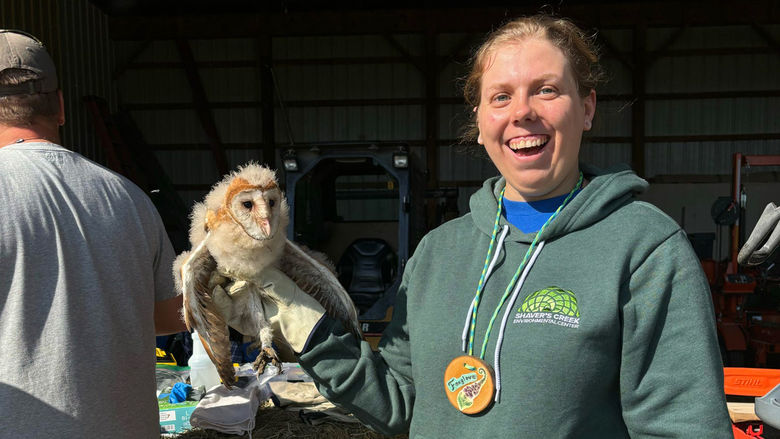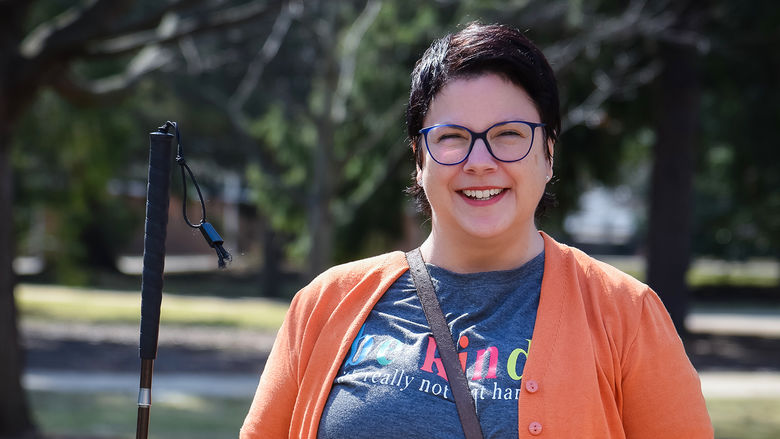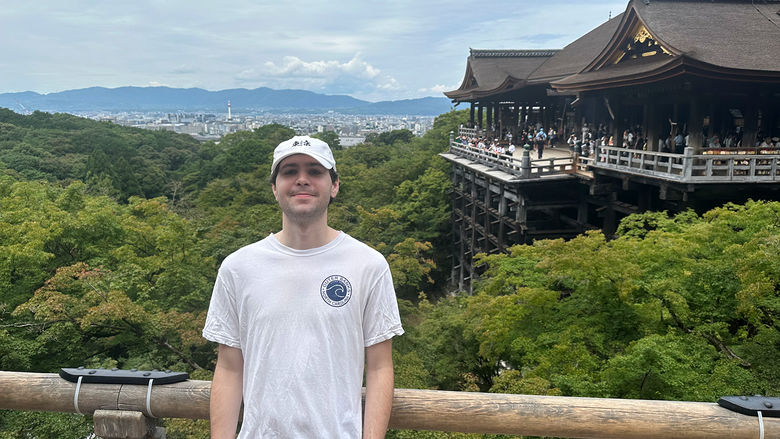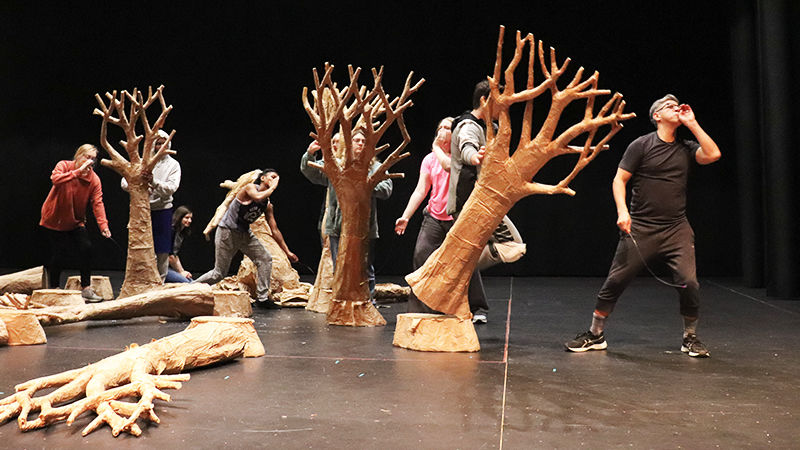

This dialog contains the full navigation menu for this site.

Laurencio Carlos Ruiz is an assistant teaching professor in theatre arts at Penn State Altoona and resident scene designer for the college’s theatre productions. In this interview, Ruiz talks about his early love of puppetry, what the art form means to him, and his newest theatre creation, theLASTree.
Penn State Altoona: When did you first discover puppets and puppetry?
Laurencio Carlos Ruiz: As a child, one of my best friends had these two Muppets, the characters from the television show, and I just loved them. I was five or six at the time, and I was so intrigued by the puppets. He let me borrow them for a bit. It wasn't enough for me to just play with them, I wanted to do something with them. I was so captivated by them, and I wanted to share that experience, so I strung up a sheet between two trees and invited people over to watch a puppet show I made up. Eight people came to see the performance. Eventually my friend wanted the puppets back. I was very reluctant to return them.
PSA: How did that love of puppetry stay with you?
LCR: When I was in college at the Universidad Autónoma Metropolitana of Mexico, there was a national television show called Guiri-Guiri, (Blabla-Blabla). It was very popular, and it aired every Sunday for half an hour. It featured a lot of props and sometimes puppets. I was fascinated by it and wanted to be a part of it. It turned out that one of my professors was doing work for the show and offered me a job in his studio. I was so excited!
PSA: What did you learn from that job?
LCR: I was still a student and now I was working a full-time job, so I learned to be efficient with time. It gave me knowledge about materials and design and about my concept of design. You have to be a multi-disciplinary artist—you need knowledge of sculpture, engineering, architecture, and geometry for that kind of work.
It was so intense, but I loved it. Ruben Valencia, the professor who gave me the job, was a visual artist, very iconoclastic. He created a studio that combined art and design. I believed in his studio and vision. At the time, what he was doing, nobody else was. Many people were afraid because it was very challenging work and out of their comfort zone. The people who were coming to us wanted complicated projects with costumes and puppetry and moving mechanisms. We always rose to those challenges. Then people from theatres started coming to us. They had seen the television show and wanted things for their productions. Some people even wanted to buy the props they saw on the show because they were so real.
I was able to do graphic design, visual arts, objects, costumes, and set pieces at that job. All of that gave me more experience, more skills and knowledge, and different venues to explore. Sometimes you stay in your comfort zone, but it's important to expand your knowledge. It was very cool, very fulfilling work.
PSA: How did you wind up in this area?
LCR: Love. Love brought me here. I met my wife in Mexico and decided to follow her when she moved here for a job. I came with just the basic knowledge of English. I planned to take some time to learn the language, and then go to graduate school. I wanted to do more learning, and I wanted to be part of the community and make a life here. Two years after moving to the area, I was accepted to University Park. I earned my masters of fine arts in scenic design.
PSA: Was there something that brought you to back to your love of puppetry?
LCR: September 11, 2001, had a big impact on my life. When I was struggling to comprehend what happened, I found that puppetry was my way to heal myself. As an artist, I see puppetry as not just a genre, but as another medium to explore my own anxiety. I decided to make a puppet show to make sense of what had happened and what I was feeling. It was called Sadomasofictions, and it was very political.
I was able to perform it at New York University’s Hemispheric Institute of Performance and Politics. The play had four puppets. I recruited actors from my master’s program to do the voices, and there were three puppeteers including myself.
PSA: How was that a springboard for you to create other puppet shows?
LCR: I'm not an actor, and I never pretend to be one, but with visual art, I can be a performing artist. After that first show, I discovered that puppetry can cross bridges and even languages. Puppetry allows me to reach out to people in a non-threatening way. I can invite audiences to different realms and have them suspend disbelief. I can use it to be political or get a message across. My intention is not just to entertain—you can find that anywhere. I want to make you think. I like to talk about serious things but with humor. I don't want to impose theology, just talk about what interests me.
I’ve done 10 puppet shows in various venues like art museums and universities. I prefer shows for adults, but some of my shows have been for kids because they are an important audience. I taught a class here at Penn State Altoona that made a production for kids and the community using traditional marionettes. It was about the creation of nature based on Hispanic legends. It was a small show with small puppets. I did another production called Give me a Hand that showed how everybody can be a puppeteer and everything can be a puppet. Another show, Oops, was about television shows that explore imagination and encourage creativity.
PSA: Your latest children’s show will be performed here in November. What is it about?
LCR: It’s called TheLASTree, and I am very excited about it. Since an early age, I have cared about the environment. I have always been conscious about the trash we produce and the pollution we create. We are all part of it and responsible for it, so I decided to write a show about that. I wanted to create something that was not so much about the spoken word, but more about the senses—what we see, hear, touch, and feel. I wrote a 50-minute play and got feedback from my colleagues in different disciplines like education and environmental studies. When I started to work on the puppets, my idea was to create ones that were partly made out of literal trash, so kids could see that they were recycled materials and see how they could reuse and recycle in everyday life.
After the show, children have the chance to meet the puppets and puppeteers. We will answer any questions they have and let them touch the puppets. Then there will be a 45-minute puppet-making workshop on stage with the support and supervision of faculty and students from Human Development and Family Studies and Elementary and Early Childhood Education.
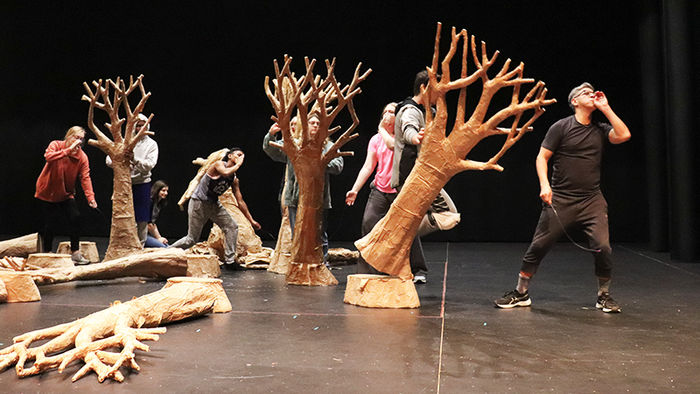
Carlos Ruiz, far right, rehearses a scene of theLASTree with students.
PSA: What's it like to be able to do puppetry at Penn State Altoona?
LCR: This is my passion, and I’m lucky that my colleagues support me. It feels good that they recognize my capacities as a creator and a thinker. That support allows me to keep growing and learning.
I appreciate that my work can be seen here. I like to share what I do, and I believe that art can really reach people. Being able to do puppetry at Penn State Altoona also helps me evolve professionally and personally. It’s helped push me out of my comfort zone at times and take chances, and that is so rewarding.
Seeing an audience happy and engaged is a confirmation, a validation of what I do. I'm not interested in fame, but I do want people to talk about my work. I want my work to make people feel and think. The two things I really believe in are work and love. That's why I put everything I can into what I create.
PSA: Do you have a favorite puppet?
LCR: No, not really. In the moment, I'm most proud of what I’m working on, but then I have another project, and I say I love this one the most.
Thursday and Friday, November 8 and 9, 2018, at 7:30 p.m.
Saturday, November 10, 2018, at 2:00 p.m.
Wolf Kuhn Theatre, Miscianga Family Center for Performing Arts
Penn State Altoona, Ivyside Campus
Tickets: $5 for Penn State Altoona students; $7 for general admission; Free for children under 12. Minors must be accompanied by an adult.
